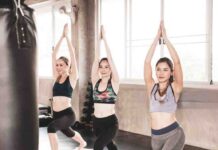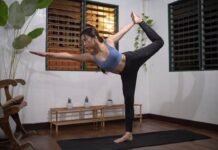Yoga is Core Power ? A Comprehensive Guide
In recent years, yoga has surged in popularity, with numerous styles and practices emerging to meet diverse needs. Among these, Core Power Yoga has carved a unique niche for itself, blending traditional yoga with modern fitness elements. It’s dynamic, strength-focused, and aimed at those seeking not only mental peace but also physical transformation. In this guide, we’ll explore the different facets of CorePower Yoga, how it differs from other types of yoga, and why it’s appealing to practitioners around the world.
Table of Contents
- Introduction to CorePower Yoga
- The Origins and Philosophy of CorePower Yoga
- Key Elements of CorePower Yoga Practice
- Power Yoga Principles
- Focus on Core Strength
- Integration of Cardio and Strength Training
- Types of CorePower Yoga Classes
- C1: CorePower Yoga 1
- C2: CorePower Yoga 2
- Hot Power Fusion
- Yoga Sculpt
- Core Restore
- How CorePower Yoga Differs from Traditional Yoga
- Emphasis on Physical Fitness
- Heat and Intensity
- Less Focus on Spirituality
- Benefits of CorePower Yoga
- Improved Core Strength
- Increased Flexibility and Mobility
- Cardiovascular Fitness
- Stress Relief
- Who Can Benefit from CorePower Yoga?
- Beginners
- Intermediate to Advanced Practitioners
- Fitness Enthusiasts
- CorePower Yoga vs. Other Popular Yoga Styles
- CorePower vs. Vinyasa
- CorePower vs. Bikram
- CorePower vs. Ashtanga
- What to Expect in a CorePower Yoga Class
- Class Structure
- Temperature and Environment
- Equipment Needed
- How to Prepare for Your First CorePower Yoga Class
- Pre-class Hydration
- Dress Code
- Mental Preparation
- CorePower Yoga and Weight Loss
- The Importance of Breathwork in CorePower Yoga
- Can You Build Muscle with CorePower Yoga?
- Is CorePower Yoga Safe ? Injury Prevention and Tips
- FAQ Section
- Conclusion
1. Introduction to CorePower Yoga
CorePower Yoga is a contemporary style of yoga that focuses on building core strength, enhancing flexibility, and improving overall fitness levels. It draws from the fundamentals of traditional yoga but integrates elements of cardio, strength training, and high-intensity interval training (HIIT). This makes it particularly appealing to those who seek a physically demanding workout alongside the calming benefits of yoga.
CorePower Yoga can be found in studios across the U.S., offering a heated environment, intense flow sequences, and a strong emphasis on fitness. But what exactly sets CorePower Yoga apart from other types of yoga? Let’s dive deeper.
2. The Origins and Philosophy of CorePower Yoga
CorePower Yoga was founded in 2002 by Trevor Tice in Denver, Colorado. Tice, a passionate yoga practitioner, wanted to create a style of yoga that was accessible, yet physically demanding, making it attractive to those who enjoy rigorous workouts. He saw an opportunity to blend the mental clarity and mindfulness of yoga with the physical challenges of strength and cardio training.
The philosophy behind CorePower Yoga centers on empowering individuals—physically and mentally—through dynamic, powerful yoga. The intention is to make yoga accessible to all fitness levels, offering modifications and advanced options in each class.
3. Key Elements of CorePower Yoga Practice
CorePower Yoga is more than just traditional poses and stretches; it combines several distinct elements that make it unique:
Power Yoga Principles
The foundation of CorePower Yoga is rooted in Power Yoga, which itself is derived from Ashtanga Yoga. Power Yoga emphasizes fluid movements that are synchronized with the breath, promoting both physical and mental endurance. The sequences are faster-paced compared to other yoga forms, and the focus is often on building strength and stamina.
Focus on Core Strength
As the name suggests, CorePower Yoga has a strong focus on building core strength. Many poses in the sequence—such as planks, boat poses, and twists—are designed to engage the abdominal muscles and stabilize the core. A strong core helps in improving balance, posture, and overall physical performance.
Integration of Cardio and Strength Training
In addition to yoga poses, CorePower integrates elements of cardiovascular training and strength exercises into its classes. Movements like squats, lunges, and even light weightlifting (in certain classes) push your body into a higher heart rate zone, making it an excellent option for those looking to burn calories and tone muscles.
4. Types of CorePower Yoga Classes
CorePower Yoga offers several class types, each tailored to different levels of experience and fitness goals:
C1: CorePower Yoga 1
C1 is an introductory-level class suitable for beginners. It introduces students to basic yoga poses, focusing on proper alignment, foundational postures, and breathwork. The pace is slower, and there’s no heat, making it ideal for newcomers.
C2: CorePower Yoga 2
This class is designed for intermediate practitioners. C2 builds upon the basics taught in C1 but adds more challenging postures, flows, and heat (around 95-98°F). You can expect a faster-paced class with more complex sequences, helping to improve both strength and flexibility.
Hot Power Fusion
A blend of traditional hot yoga and power yoga, Hot Power Fusion takes place in a heated room (about 100°F) and emphasizes balance and flexibility. The combination of heat and fluid movements enhances detoxification, helps loosen tight muscles, and challenges mental focus.
Yoga Sculpt
Yoga Sculpt is a unique hybrid class that combines yoga with strength training. It incorporates light weights, resistance exercises, and high-intensity cardio bursts. This class is designed to boost metabolism and build lean muscle mass while still offering the calming benefits of yoga practice.
Core Restore
A more meditative and restorative class, Core Restore focuses on deep stretching and relaxation. It’s perfect for those who need to unwind after a stressful day or recover from more intense classes. It offers fewer poses but holds them for longer periods, promoting deep tissue release and mental clarity.
5. How CorePower Yoga Differs from Traditional Yoga
CorePower Yoga may have its roots in traditional yoga practices, but there are significant differences that set it apart:
Emphasis on Physical Fitness
While many forms of traditional yoga focus on the mind-body connection and stress relief, CorePower Yoga places a stronger emphasis on physical fitness and strength building. Classes are designed to challenge the muscles, particularly the core, and increase cardiovascular endurance.
Heat and Intensity
CorePower Yoga classes often take place in heated rooms, ranging from warm to hot (up to 105°F in some cases). This creates a sweat-inducing, intense environment that can help with flexibility, detoxification, and calorie burn.
Less Focus on Spirituality
Many traditional yoga practices incorporate aspects of spirituality, meditation, and mindfulness. While CorePower Yoga doesn’t completely discard these elements, the primary focus is more on physical achievement and fitness goals rather than spiritual enlightenment.
6. Benefits of CorePower Yoga
CorePower Yoga offers a wide range of benefits that go beyond just the physical body. Here are some of the key advantages:
Improved Core Strength
With its targeted core exercises and postures, CorePower Yoga strengthens the abdominal muscles and helps to improve balance and stability. This core strength benefits not only your yoga practice but also daily activities and athletic performance.
Increased Flexibility and Mobility
The dynamic sequences and heat in CorePower Yoga classes allow for deeper stretches, which can improve flexibility and range of motion over time. Regular practice can help to loosen tight muscles and joints.
Cardiovascular Fitness
Because of the fast-paced, flowing movements and the addition of strength and cardio elements, CorePower Yoga provides a full-body workout that improves cardiovascular endurance. It’s a great way to elevate your heart rate while building strength.
Stress Relief
Like all forms of yoga, CorePower Yoga promotes mindfulness and stress relief. The deep breathing techniques and focused movement help reduce anxiety and promote relaxation, even during more intense classes.
7. Who Can Benefit from CorePower Yoga?
One of the great things about CorePower Yoga is that it’s accessible to a wide range of people, regardless of fitness level:
Beginners
With classes like C1 and Core Restore, CorePower Yoga offers an excellent introduction to yoga for beginners. The structure allows newcomers to learn foundational postures and work on flexibility before moving on to more intense classes.
Intermediate to Advanced Practitioners
For those who already have some yoga experience, classes like C2 and Hot Power Fusion offer the opportunity to take their practice to the next level, incorporating more challenging postures, sequences, and heat for a deeper workout.
Fitness Enthusiasts
If you’re looking for a workout that combines the benefits of yoga with strength training and cardio, CorePower Yoga offers classes like Yoga Sculpt that will push your physical limits and help you build muscle and burn calories.
8. CorePower Yoga vs. Other Popular Yoga Styles
To truly understand what makes CorePower Yoga unique, let’s compare it to other well-known yoga styles:
**CorePower vs
. Vinyasa**
Both CorePower and Vinyasa Yoga focus on linking movement with breath in a continuous flow. However, CorePower Yoga tends to have a more intense, fitness-driven approach, often incorporating heat and strength training, whereas Vinyasa can be more fluid and meditative.
CorePower vs. Bikram
Bikram Yoga also takes place in a hot room but follows a strict sequence of 26 poses. CorePower Yoga, on the other hand, offers more flexibility in its sequences and classes. CorePower also includes cardio and strength elements, which are absent in the traditional Bikram sequence.
CorePower vs. Ashtanga
Ashtanga Yoga is a rigorous style that follows a set series of postures in a particular order. While CorePower Yoga draws inspiration from Ashtanga, it is less rigid in structure and incorporates more strength training and heat.
9. What to Expect in a CorePower Yoga Class
Whether you’re stepping into a CorePower studio for the first time or taking an online class, here’s what you can typically expect:
Class Structure
Most classes begin with a brief warm-up, followed by vinyasa-style flows designed to build heat and strength. After this, you’ll move into more challenging sequences and core exercises before cooling down with stretching and relaxation.
Temperature and Environment
CorePower Yoga classes are often held in heated rooms, which can range from 90°F to over 100°F, depending on the class type. The heat helps increase flexibility and encourages detoxification through sweat.
Equipment Needed
In most classes, all you’ll need is a yoga mat and a water bottle. For Yoga Sculpt, you might also use light hand weights and resistance bands to intensify the workout.
10. How to Prepare for Your First CorePower Yoga Class
Before attending your first class, consider the following tips:
Pre-class Hydration
It’s essential to drink plenty of water before attending a heated CorePower Yoga class. The heat will cause you to sweat more than usual, so arriving well-hydrated will prevent dehydration and help you power through the class.
Dress Code
Wear light, moisture-wicking clothing that allows for movement and keeps you cool in the heated environment. Avoid heavy fabrics like cotton that can absorb sweat and become uncomfortable.
Mental Preparation
While CorePower Yoga is physically demanding, it’s important to approach it with a calm mind and open heart. Be ready to challenge yourself but also to listen to your body’s limits.
11. CorePower Yoga and Weight Loss
Due to its emphasis on cardiovascular fitness and muscle-building, CorePower Yoga can be an effective tool for weight loss. The high-intensity classes, especially Yoga Sculpt, burn a significant amount of calories and help increase muscle tone, both of which contribute to fat loss when combined with a healthy diet.
12. The Importance of Breathwork in CorePower Yoga
Although CorePower Yoga focuses on physicality, the breath still plays a critical role in practice. The sequences are designed to synchronize breath with movement, promoting endurance and a calm mind even during challenging postures.
13. Can You Build Muscle with CorePower Yoga?
Absolutely! Many of the poses in CorePower Yoga, like planks, warrior sequences, and weight-bearing postures in Yoga Sculpt, are specifically designed to engage the muscles. Regular practice builds lean muscle mass, particularly in the core, arms, and legs.
14. Is CorePower Yoga Safe? Injury Prevention and Tips
As with any workout, it’s important to practice safely in CorePower Yoga. If you’re new to yoga or intense workouts, take it slow and don’t push your body too far, especially in the heated classes. Proper alignment is key, so consider asking your instructor for guidance if you’re unsure about a pose.
15. FAQ Section
1. Is CorePower Yoga suitable for beginners?
Yes, CorePower Yoga offers beginner-friendly classes like C1, which provide a great introduction to yoga fundamentals in a non-heated environment.
2. Do I need prior yoga experience for CorePower Yoga?
No prior experience is necessary. CorePower Yoga offers classes that cater to all levels, from complete beginners to advanced practitioners.
3. How often should I do CorePower Yoga for the best results?
For optimal results, aim to practice 3-4 times a week, mixing different class types to target strength, flexibility, and cardio.
4. Can I lose weight with CorePower Yoga?
Yes, CorePower Yoga’s focus on high-intensity cardio and strength exercises can aid in weight loss when combined with a balanced diet.
5. What should I bring to a CorePower Yoga class?
Bring a yoga mat, a towel, and a water bottle. If you’re attending a Yoga Sculpt class, light hand weights might also be required.
6. Can I practice CorePower Yoga if I’m pregnant?
It’s best to consult your doctor before practicing heated yoga during pregnancy. CorePower also offers non-heated classes like Core Restore, which may be more suitable.
16. Conclusion
CorePower Yoga blends the best of yoga’s calming, centering qualities with the power of a high-intensity workout, creating a unique practice that builds strength, flexibility, and mental clarity. Whether you’re looking to improve your fitness, reduce stress, or try something new, CorePower Yoga offers something for everyone, from beginners to seasoned athletes. With its varied class offerings, heated environment, and emphasis on core strength, it’s no wonder CorePower Yoga has become a popular choice for those seeking both mental peace and physical transformation.
What Type of Yoga is CorePower


